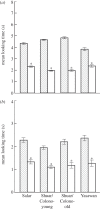Early false-belief understanding in traditional non-Western societies
- PMID: 23363628
- PMCID: PMC3574387
- DOI: 10.1098/rspb.2012.2654
Early false-belief understanding in traditional non-Western societies
Abstract
The psychological capacity to recognize that others may hold and act on false beliefs has been proposed to reflect an evolved, species-typical adaptation for social reasoning in humans; however, controversy surrounds the developmental timing and universality of this trait. Cross-cultural studies using elicited-response tasks indicate that the age at which children begin to understand false beliefs ranges from 4 to 7 years across societies, whereas studies using spontaneous-response tasks with Western children indicate that false-belief understanding emerges much earlier, consistent with the hypothesis that false-belief understanding is a psychological adaptation that is universally present in early childhood. To evaluate this hypothesis, we used three spontaneous-response tasks that have revealed early false-belief understanding in the West to test young children in three traditional, non-Western societies: Salar (China), Shuar/Colono (Ecuador) and Yasawan (Fiji). Results were comparable with those from the West, supporting the hypothesis that false-belief understanding reflects an adaptation that is universally present early in development.
Figures




References
-
- Dally JM, Emery NJ, Clayton NS. 2006. Food-caching western scrub-jays keep track of who was watching when. Science 312, 1662–166510.1126/science.1126539 (doi:10.1126/science.1126539) - DOI - DOI - PubMed
-
- Call J, Tomasello M. 2008. Does the chimpanzee have a theory of mind? 30 years later. Trends Cogn. Sci. 12, 187–19210.1016/j.tics.2008.02.010 (doi:10.1016/j.tics.2008.02.010) - DOI - DOI - PubMed
-
- Marticorena DCW, Ruiz AM, Mukerji C, Goddu A, Santos LR. 2011. Monkeys represent others’ knowledge but not their beliefs. Dev. Sci. 14, 1406–141610.1111/j.1467-7687.2011.01085.x (doi:10.1111/j.1467-7687.2011.01085.x) - DOI - DOI - PMC - PubMed
-
- Baillargeon R, He Z, Setoh P, Scott RM, Sloane S, Yang Y. In press. False-belief understanding and why it matters: the social-acting hypothesis. In Navigating the social world: what infants, children, and other species can teach us (eds Banaji MR, Gelman S.). New York, NY: Oxford University Press
-
- Sperber D, Wilson D. 1995. Relevance: communication and cognition, 2nd edn Oxford, UK: Blackwell
Publication types
MeSH terms
LinkOut - more resources
Full Text Sources
Other Literature Sources
Medical

